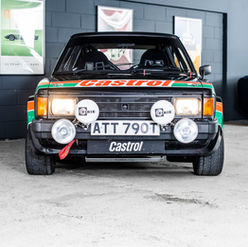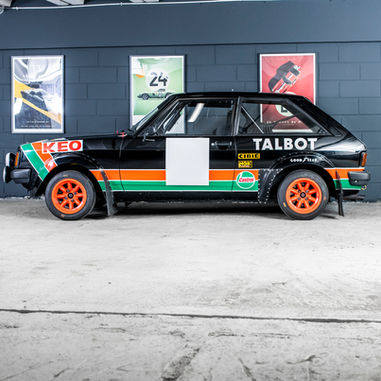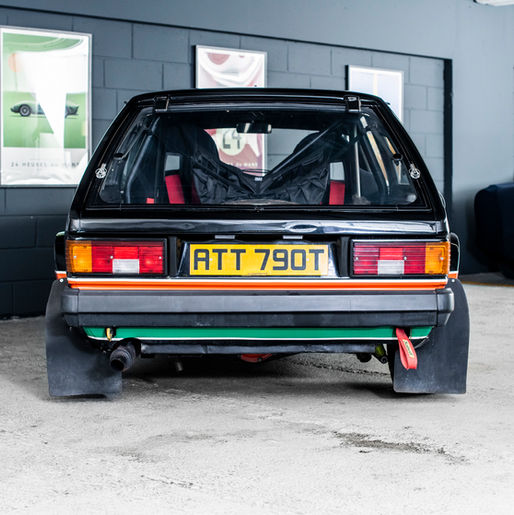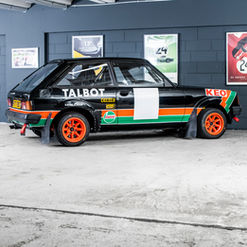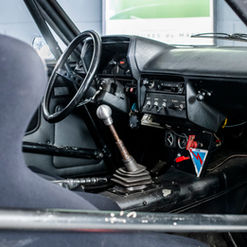This is the story of a car that has made rally car enthusiasts dream and still does. But while some of these cars were born noble and have only become more refined, this one started from very, very low beginnings. We tell you the story of an improbable tinkering and a career full of twists and turns.
Takeover, jealousy and Scottish rescueIf we want to go back a long way, let's start with the story of the Talbot Sunbeam in June 1964. Chrysler attacked the British market by taking a 30% stake in the Rootes group. It was a similar mechanism to the one used on the continent with Barreiros or Simca. Pentastar increased its shareholding by successive additions until 1967, when it took majority control and the Rootes name disappeared, to be replaced in 1971 by Chrysler UK, an entity headed by Chrysler Europe, which brought together the two aforementioned brands.
In the UK, British Motor Holdings and Leyland Motor Corporation merged in 1968 to form the British Leyland Motor Company. But after only 6 years, the company, born of two parties in bad shape, was in dire straits. Sir Don Ryder was commissioned by the government to take stock of the ‘English General Motor’ (at least that was the group's ambition). Ryder submitted his report in 1975, and it was sufficiently alarmist for the government to decide to get involved. The group could disappear and the Labour government did not want to see thousands of workers laid off. British Leyland Limited was created, with the government as majority shareholder and a large injection of sterling.
Chrysler UK saw this as unfair competition, and to some extent they were right. As a result, the group threatened to become much more powerful than it was at present and put the survival of the unprofitable Linwood plant in Scotland (west of Glasgow) on the line. The government responded by allocating a grant of £55,000,000 to develop a compact, modern car to be built in Scotland. At that point: ‘y a plus qu'à’.
The killer ingredient: new from old
Just because you've got £55 million (which these days would be equivalent to about €3 billion) doesn't mean you have to spend it all on a new car. While no-one has ever uttered this phrase, what you're about to read suggests that it was the guiding idea behind the birth of the Talbot Sunbeam.
In January 1976, the R424 project was launched. But the schedule and the budget were tight. This had an impact on the technical side of the project. For a start, we weren't going to launch a new platform. The Hillman Avenger will serve as the basis. The car came out in 1970, and its components are easily reusable, so it's a perfect candidate.
However, it was to be a compact car, not a saloon, so the wheelbase was reduced by 76 mm. The engine is a 928cc, itself derived from the 875cc engine based on the Coventry Climax FWMA, a pump engine from the 1950s! Two other engines, a 1300 and a 1600 are also on the program.
In terms of styling, the car was designed by the Whitley studio headed by Roy Axe, which also belonged to Chrysler UK. As a result, the car's styling will be similar to Chrysler Europe's latest creations: the Simca 1307 (Chrysler Alpine on the other side of the Channel) and the future Simca Horizon. In fact, the headlamps of the latter are to be borrowed, but the timetable is much longer and it soon becomes clear that they won't be ready in time... hence the reuse of the Avenger's ‘recessed’ headlamps.
Put like that, it sounds simple. But the R424 project is in fact full of compromises. First and foremost, a technical compromise. While the group's new cars tend towards front-wheel drive, which is much more modern, the use of the Avenger platform means that they have to be rear-wheel drive.
Even in form, the new car is not all that free. To prevent it from competing with the future Horizon, it will be limited to 3 doors. This implies a final compromise on the structure, with a relatively high boot load sill given that only the rear window opens!
On these last two points, the difference with the Horizon (5-door front-wheel drive) is clear to see. But that doesn't prevent a lot of confusion
There's one final point: the name. The Sunbeam brand was used for exporting Rootes group cars. Chrysler UK wanted to do away with the name... but ended up using it for the model. The Chrysler Sunbeam was born!
The career of the Chrysler Sunbeam
19 months. That's how long it took the design office to create the Chrysler Sunbeam. It was presented on 23 July 1977 and the British press took a positive view of the car. The styling was more modern than that of the Avenger (whose 2-door version was discontinued) and the three engines and three trim levels (LS, GL and S) sold well.
At the 1978 Paris Motor Show, a new version was added to the range: the Sunbeam Ti. The car was based on the Avenger Tiger, from which it took the 1,598cc engine, but boosted by two Weber carburettors. Power reaches 100 bhp in a rear-wheel drive compact, a first step into the world of the Hot Hatch, much sought-after on the other side of the Channel.
Dynamic is good, sporty is even better. So Chrysler UK did what Ford had done before, turning to Lotus to bring out a supercharged version of the compact. The result was the Lotus Sunbeam. While its engine was indeed a 2.2-litre unit, it had nothing to do with the Chrysler block of the same displacement (which originated in the Simca-Chrysler 160, 180 and 2 Litres).
It was the Lotus Type 907 engine, used in the Lotus Elite, Eclat, Esprit and Jensen-Healey, which was upgraded from 1973 to 2172 cm³, becoming Type 911, and housed under the bonnet. 4 cylinders, 16 valves, 150 bhp! Now there's going to be some sport. It was mated to a ZF gearbox and of course the running gear was reworked.
But the car was not to be called Lotus Sunbeam. It was presented at the Geneva Motor Show in March 1979. And before that... there was a big change.
The Chrysler becomes the Talbot Sunbeam
While Hethel was preparing a car ready for sport, and rallying in particular, Chrysler UK was in dire straits. The Sunbeam was used to bring in a subsidy, but that didn't guarantee huge sales. They weren't catastrophic, but that didn't mean the car was a huge success. Overall, Chrysler UK cars are selling poorly, Simca cars are losing ground while the Horizon is still in its launch phase and Simca-Chrysler cars have been quickly overtaken. In short, Chrysler was in a quagmire and wanted out.
To avoid bankruptcy and get the Poissy plant back, the PSA Group, which really didn't need this, bought the group, its production facilities and its models specific to the British market. The takeover took effect on 1 January 1979. On 1 August 1979, Chrysler Sunbeam became Talbot Sunbeam. But little else was changed. Although the Chrysler badge disappeared from the bonnet, the Talbot Sunbeam kept its Pentastar grille until 1981!
The Simca-Chrysler Sunbeam Lotus bodies came off the assembly line at the Linwood (Glasgow) factory and were transported by truck to an aircraft hangar built by Lotus at a site near Norwich.
The engines came from the historic Ethel factory, some thirty kilometres away, and the ZF gearboxes arrived directly from Germany. In the hangar, a team of around fifteen mechanics fitted the engine and gearbox into the hull after enlarging the transmission tunnel to make room for the gearbox. The whole assembly was then sent to Coventry before being dispatched to the dealers.
Three years after the launch of the 110bhp Golf GTI, the launch of the Lotus Sunbeam at the Geneva Motor Show in March 1979 caused a sensation. With 155 bhp, the Sunbeam was the queen of the road.
In July 1979, Peugeot decided to revive a brand it owned in order to unify ex-Chrysler production: Talbot. Fortunately, this had no impact on the Sunbeam Lotus programme or on competition.
The first production cars were already in stock in Great Britain, so they had to be rebadged as a matter of urgency before delivery. The Sunbeam Lotus would be delivered with Talbot (front left), Simca (rear left), Sunbeam (rear right), Lotus (sides) and the Chrysler logo engraved in the plastic of the grille.
Coming back to the sports car, the Lotus, it was unveiled after the takeover. Except that the first cars were not ready immediately. They were not delivered until after 1st August, and in the meantime had become Talbot Sunbeam Lotuses. They were to shine in rallies, but more about that below.
It was not until 1981 that the Talbot Sunbeam really evolved. They were given a 4-year restyling that allowed them to receive, at last, flush-fitting headlights! At the same time, the Pentastar was removed from the radiator grille, which was completely meaningless.
The plans for this restyling were in the box. So we brought it out. However, the fate of the Talbot Sunbeam was already sealed. The Linwood plant was saved under Chrysler, not PSA. It is still not profitable, and the group has decided to close it. This means the end of the Avenger... which is still the basis for the Talbot Sunbeam. PSA has no regrets. The Avenger competes with the 305 and the Talbot Sunbeam remains positioned opposite the Horizon, whatever Chrysler may have done. These two cars were more modern.
1981 was therefore the last year of Talbot Sunbeam production. Taking all models (Chrysler and Talbot) together, around 200,000 cars were produced. The last Talbot Sunbeam Lotus cars were hard to sell and were produced in a special ‘Avon’ series, numbered in 1982.
The Talbot Sunbeam Lotus in rallies
Although the car arrived at a time when the history of the basic model was becoming really bad, its lightning career was to make it a myth, quite simply. It was not homologated in Group 2 until 1980, by which time the necessary 1,000 cars had been built.
For world championship rallies, the engine was increased to 250 bhp.
In March, it scored its first podium finish with Guy Fréquelin at the wheel and Jean Todt as co-driver: 3rd in the Rally Portugal. Its big breakthrough that year came at the RAC. Henri Toivonen, co-driven by Paul White, won the rally and the two Frenchmen finished 3rd. With a few points scored in Italy, the Talbot Sunbeam Lotus finished 6th in the championship.
1981: the world title
That year, the Talbot Lotus Sunbeam challenged the established manufacturers with a formidable team
Guy Fréquelin (main driver)
Henri Toivonen (rising rally star)
Stig Blomqvist and Russell Brookes on certain rounds
In 1981, Fréquelin and Todt got off to a strong start with 2nd place in the Monte Carlo Rally. Toivonen and Gallagher then took 2nd place in Portugal and the two Frenchmen achieved a similar result in the Tour of Corsica. Better still, they won Argentina in July and came 2nd in Brazil in August. Toivonen and Gallagher snatched another 2nd place in San Remo and the year ended with Blomsvist and Cederberg finishing 3rd in the RAC.
Although Fréquelin was ‘only’ second in the drivers' standings behind Ari Vatanen (in a Ford Escort), the Talbot Sunbeam Lotus became World Rally Champion... just a few weeks before it was to be discontinued!
Talbot Sunbeams today
It's very rare to come across one. But like many popular cars of the time, only the vitamin-packed versions of the Talbot Sunbeam have survived. So we end up with a rare car...
Dimi Mavropoulos took delivery of his car, built at the time by Talbot's Coventry racing department, from the brand's factory cars. As such, it was equipped with all the same parts as the Group 2 ‘works’ cars.
This historic Sunbeam Lotus competed in the Castrol Autosport Championship in England and the 1979/80/81/83/84 European Rally Championship.
In the 1980s, its Cypriot driver distinguished himself in rallying by becoming Cyprus Rally Champion on several occasions. He also distinguished himself in the UK in the rallycross discipline.
At the wheel of this Sunbeam Lotus, he achieved several podiums, finishing second in 1981 and 1982, and once third (in Group B) in 1984.
This Sunbeam Lotus received factory support for its construction and was one of the very first Sunbeams to be homologated for rallying. As such, it was fitted with the original factory parts, which it has retained: factory wiring harness, reinforced body, Salsbury self-locking axle, minilite wheels, quick-release axle, 48 mm Solex carburettor, twin fans, adjustable front/rear brake distribution, hydraulic handbrake, large radiator, dry sump.
Sold in the 1980s to a driving school near Silverstone (Rally Racing Ltd), it was acquired a few years later by a Swiss private individual who carried out the first major restoration work (many photos attached to the file). Repainted in white, the ATT 790T has changed from its original Castrol livery to a factory Chrysler Competition livery, easily identifiable by rally enthusiasts.
Acquired in the early 2010s by an enthusiast living in the Rhône-Alpes region, he set about restoring the car in full compliance with its Group 2 homologation sheet. It was also during this period that the owner decided to convert this Talbot Sunbeam Lotus into an LHD.
Sold in 2017 to its previous owner, a collector living in Haute-Savoie, before ending up in the hands of its current owner.
Since then, the Sunbeam Lotus has taken part in a number of test drives.
It has its original registration and has been restored to comply with the Group 2 homologation form.
Eligible for the Tour de Corse Historique, Rallye de San-Remo, Rallye Costa Brava, Rallye de l'Acropole....
This Sunbeam Talbot Lotus is accompanied by an extensive history file, its FIA PTH (period I) and all recent invoices relating to the engine rebuild.
KNOWN PERIOD HISTORY OF ‘ATT 790T’
31 January 1981 / Wyedean Stages / Mavropoulos - Adams / 30th OA
30 May 1981 / Centurion Rally / Mavropoulos - Adams / 36th OA
27 September 1981 / European Rally Championship / Cyprus / 2nd OA
3 April 1982 / Plains National Rally / Mavropoulos - Adams / 39th OA
5th June 1982 / Centurion Rally / Mavropoulos - Adams / 13th OA
17 July 1982 / Border Counties Rally / Mavropoulos - Barnsley / 64th OA
26 September 1982 / European Rally Championship / Cyprus / 2nd OA
1982 / Goodyear Lakeland-Ford Rally / Mavropoulos - Adams / 32th OA
1982 / Sutherland Dukeries Rally / Mavropoulos - Adams / DNF
1983 / Peter Russek Manuals Rally / Mavropoulos - Adams / 20th OA January 1984 / Wyedean Stages / Mavropoulos - Adams / 54th OA
